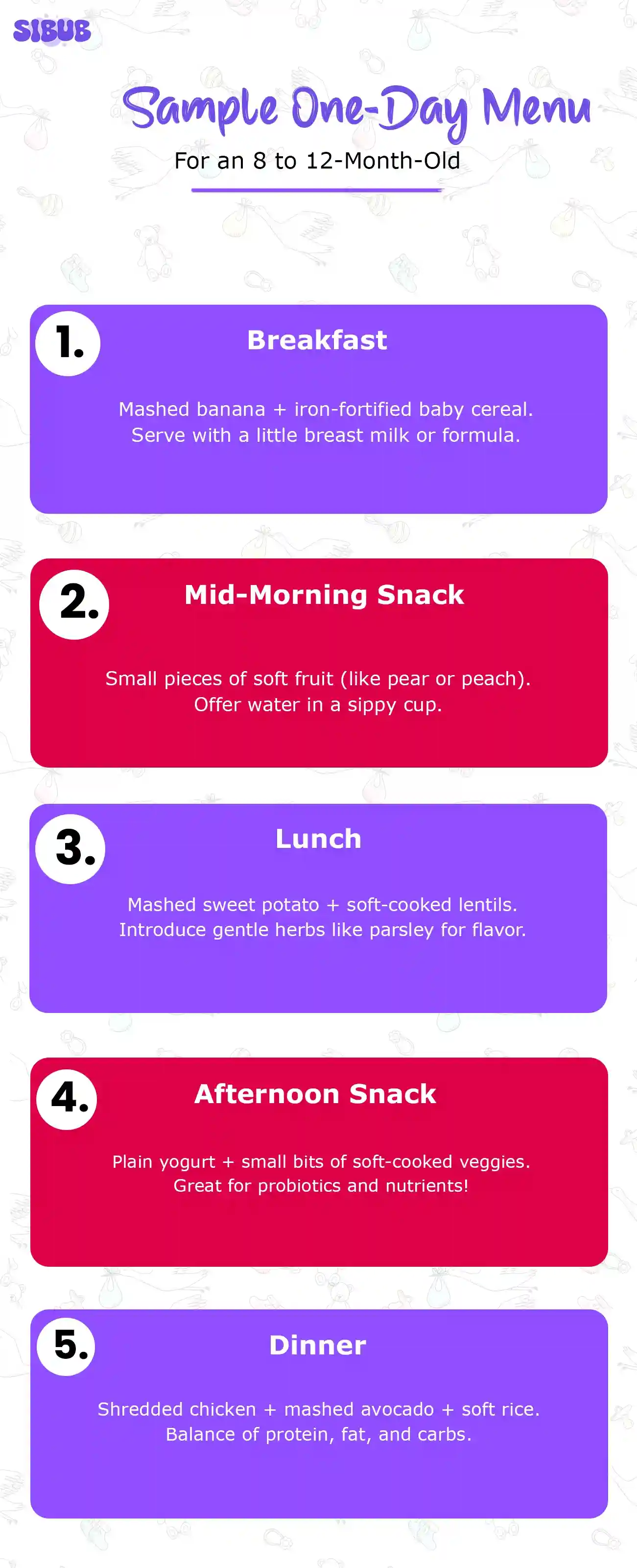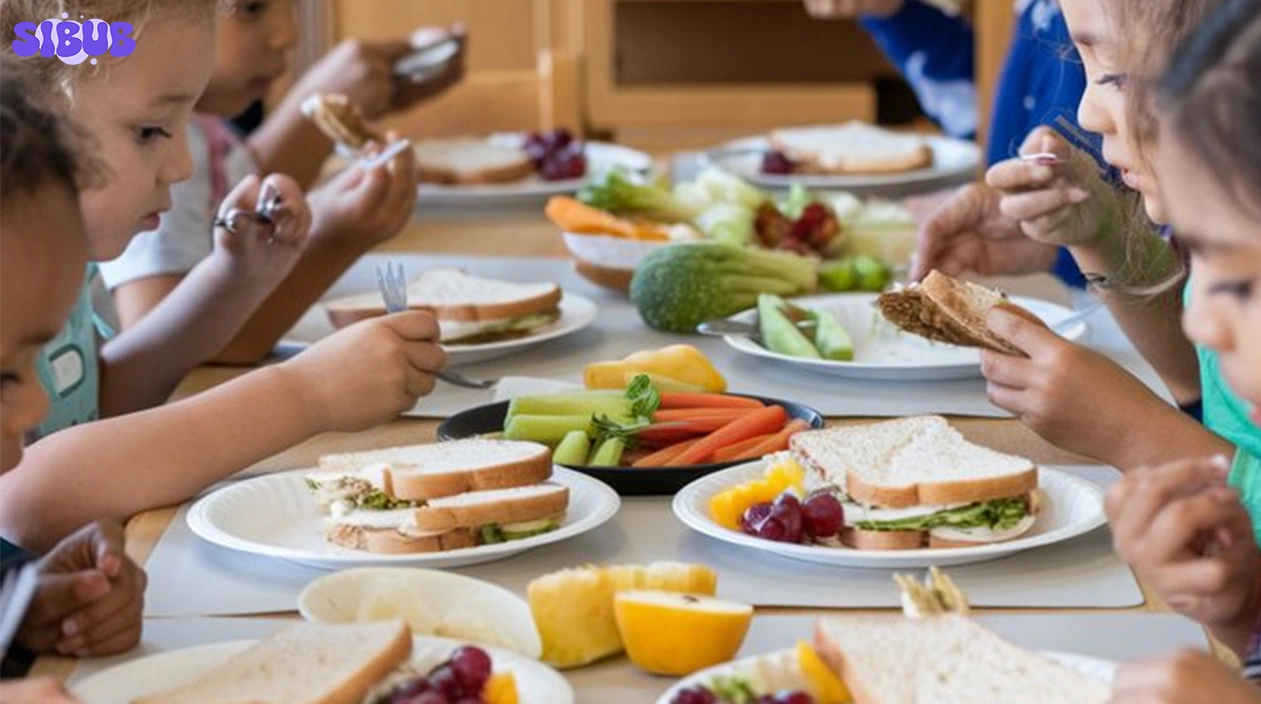Finding the right 9 month old food ideas can be overwhelming for new parents. As your baby grows and explores the world of solid foods, it becomes important to offer balanced meals that support development, growth, and good eating habits. This guide provides a complete feeding plan for 8 month old babies and older, offering meal suggestions that are nutritious, simple, and age-appropriate.
Understanding Your Baby’s Nutritional Needs
By the time your baby is between 8 and 12 months old, their nutritional needs shift slightly. While breast milk or formula remains essential, solid foods begin to play a much bigger role. Your baby may need about 750 to 900 calories per day, with roughly 400 to 500 of those calories still coming from breast milk or formula (around 24 ounces).
Introducing Texture and Variety
At this stage, babies are ready for thicker purees, mashed foods, and soft, small pieces they can chew. You can slowly transition away from strained foods and move toward fork-mashed or chopped textures. Soft fruits, cooked vegetables, whole grains, and proteins should be part of their regular diet.
Offering variety not only helps with nutrition but also encourages your baby to enjoy different flavors and textures. That makes it easier to introduce more complex foods as they grow.
9 Month Old Food Ideas: What Can a 9 Month Old Eat?
If you’re looking for meal ideas for 9 month old babies, it helps to focus on soft, easy-to-digest foods rich in vitamins, minerals, and healthy fats. Here are some ideas:
- Mashed or scrambled eggs
- Mashed avocado
- Full-fat Greek yogurt
- Mashed banana
- Soft-cooked and chopped vegetables (carrots, squash, sweet potatoes)
- Soft fruits (pears, peaches, ripe strawberries)
- Small pieces of soft cheese or tofu
- Ground or finely chopped poultry and meat
These 9 month old food ideas are just the beginning. With proper planning, you can create a balanced menu that supports your baby’s development.

Visit: 12 Tips to Help Your Child Become Friends with Kids Easily and Confidently
Sample One-Day Feeding Plan for 8 Month Old to 12 Month Old
Below is a sample feeding plan that works across the 8 to 12-month range. It includes flexible options, so you can adjust portions and foods based on your baby’s preferences and eating skills.
Breakfast
- 2 to 4 ounces of iron-fortified baby cereal or one scrambled egg
- 2 to 4 ounces of mashed or diced fruit (such as banana or peaches)
- Breast milk or 4 to 6 ounces of formula
Why it works: This meal offers iron, protein, and healthy carbs. Eggs and fortified cereal provide essential nutrients for brain development.
Morning Snack
- 4 to 6 ounces breast milk or formula
- 2 to 4 ounces of soft-cooked vegetables or diced cheese
Tip: For easy prep, steam veggies in bulk and store in the fridge. Mild cheeses like mozzarella are gentle on little tummies.
Lunch Ideas for a 9 Month Old Eating Plan
- 2 to 4 ounces of yogurt, cottage cheese, or soft-cooked beans
- 2 to 4 ounces of cooked yellow or orange vegetables (carrots, pumpkin, sweet potatoes)
- 4 to 6 ounces of breast milk or formula
Why it works: This lunch is protein-rich and introduces fiber and color into the diet. Bright vegetables are full of vitamins A and C.
Discover: Why the First 5 Years Matter – How Early Childhood Shapes Who They Become
Afternoon Snack
- 1 whole grain cracker or teething biscuit
- 2 to 4 ounces of yogurt or mashed soft fruit (like ripe pear)
- 2 to 4 ounces water
Why it works: Encourages self-feeding and builds motor skills. Water helps with digestion and hydration.

Dinner Meals for 10 Month Old and Beyond
As your baby grows closer to one year, dinner becomes an opportunity to mirror family meals with slight modifications. Here’s a wholesome example:
- 2 to 4 ounces of soft diced chicken, tofu, or ground meat
- 2 to 4 ounces of cooked green vegetables (zucchini, peas, green beans)
- 2 to 4 ounces of soft whole grains like pasta, rice, or potatoes
- 2 to 4 ounces of diced or mashed fruit
- Breast milk or 4 to 6 ounces of formula
How much should a 10 month old eat? Generally, your baby will let you know when they’re full. Offer small portions and let them explore the food. Keep an eye out for hunger and fullness cues.
Before Bed
- 6 to 8 ounces of formula or breast milk
- Water for oral hygiene or brushing teeth after
Nighttime feedings may slowly reduce around this age, but every baby is different. Some may still need the comfort of a bedtime bottle.
Explore: How to Play Poker: Simple Rules for Beginners
Tips for Successful Feeding
1. Respect Baby’s Appetite
Some days your baby will eat more than others. That’s okay. Forcing food can create negative associations with mealtime.
2. Embrace Finger Foods
Soft-cooked carrots, small banana pieces, and shredded cheese are perfect for self-feeding. This also improves hand-eye coordination.
3. Introduce One New Food at a Time
Wait 3–5 days before adding another new food. This helps you watch for allergies or sensitivities.
4. Make Meals Colorful
Bright veggies and fruits don’t just look appealing, they’re full of nutrients. Try sweet potatoes, blueberries, and spinach.
5. Keep It Simple
You don’t need gourmet meals. Steam, mash, chop, and serve. Focus on real, whole foods.
Meals for 9 Month Old: Avoid These Foods
Certain foods should still be avoided at this age:
- Honey (risk of botulism)
- Whole nuts and chunks of nut butter (choking hazard)
- Popcorn and hard candies
- Excess salt or sugar
- Raw vegetables that are hard to chew
Instead, stick to soft, easy-to-eat foods and limit seasonings.

Learn More: Top One Minute Challenges for Middle Schoolers: Fun & Easy Game Ideas
Sample Grocery List for 9 to 12 Month Old Meal Prep
Here are pantry and fridge staples for building nutritious meals for 9 month old and older:
Proteins:
- Eggs
- Plain Greek yogurt
- Ground turkey or chicken
- Beans and lentils
- Cottage cheese
Vegetables:
- Carrots
- Sweet potatoes
- Zucchini
- Green beans
- Squash
Fruits:
- Bananas
- Pears
- Apples (cooked and mashed)
- Strawberries
Grains:
- Baby cereal
- Oats
- Whole grain pasta
- Brown rice
Healthy fats:
- Avocado
- Olive oil (drizzle lightly)
- Nut butters (spread thinly and watch closely)
Check this out: Baby Empathy: Do Babies Really Feel It? What Science Reveals
What Can a 9-Month-Old Eat? Variety is Key
The more you expose your baby to new textures and tastes, the more adventurous they’ll likely become. Make it fun. Let them get messy. Sing songs. Talk about the food. Use a high chair with good support, and always supervise.
Therefore…
Creating a balanced 9 month old eating plan doesn’t have to be complicated. With simple ingredients and a little planning, you can prepare meals that your baby enjoys while supporting their development.
A structured day with 3 meals and 2 to 3 snacks, combined with breast milk or formula, is ideal. Watch your baby’s cues. Offer a mix of carbs, protein, healthy fat, and fiber. Most importantly, let your baby enjoy the experience of learning to eat.
